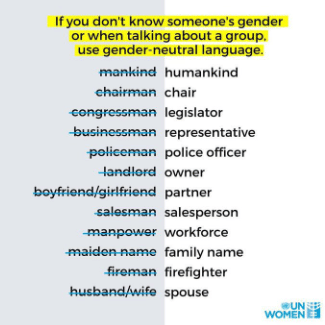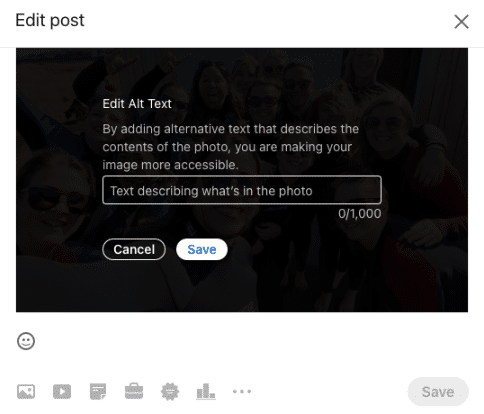
It’s not a woke thing. It’s a welcome-all-folk thing.
This blog is not about the greater work of workplace equity and diversity.
Stephi, one of our Client Marketing Managers, has already written an excellent resource on how to build a multicultural team within your accounting firm. And you can apply each of the 3 actionable tips in this blog to your marketing for hiring and careers.
This is about taking small steps to create content that everyone in your audience can consume, understand and relate to.
Why wouldn’t we want to open more doors to our services and support?
Inclusivity is not about widening your audience – it’s about welcoming everyone within it
Great marketing is rooted in the experiences, problems and needs of your audience.
When the net is cast really wide, those experiences, problems and needs become so varied and it’s hard to pinpoint the common denominators. As a result your content becomes more generalised and less effective.
The idea is to catch the attention of your very ideal clients (make them say “that’s so me!”) and focus all your messaging on them.
When we talk about making your content more inclusive, we mean more inclusive within your defined ideal audience.
For example:
- If you’re an accounting firm that specialises in helping parents in business, is there an opportunity to represent different parental setups in your imagery?
- If you’re best at helping young creative entrepreneurs, could you make it so that all people within that group have equal access to your content?
You don’t need to pivot off-brand suddenly and be everything to everyone. You can be authentically you and make more inclusive choices.
Three ways your content can show up for more people: make it reflective, accessible and representative
1. Make it more reflective
- Check your stock imagery: your opportunity to feature images of people of different ages, genders, ethnicities, faiths, abilities, sexualities, cultural backgrounds.
Here are some examples to explore (but there are lots more out there!):
Beautiful photos of Black and Brown people from Nappy
All body shapes and sizes from Getty
The gender spectrum collection from Vice
Progressive stock imagery from Stocksy
The Despora collection from The Unmistakeables
The Disabled and Here collection
The Age positive image library
The Latinx photo collection from Jopwell
Look for areas where you can make an inclusive switch:
Work with tech companies but only ever show stock images of men? > Check out this women in tech collection from Flickr.
Work with parents in business but only featuring white families? > Check out this diverse family collection on Pexel.
Got a brand that features a lot of illustration? Check out some more inclusive libraries, such as:
Open peeps hand drawn illustrations library
Black illustrations.com
- Check your language: How might language have evolved or progressed? Spot check yourself for stereotypes and seek opportunities to welcome rather than alienate.
-Parents might not be ‘mum and dad’
– A couple might not be a husband & wife
– Re-evaluate where you might be using problematic language casually, like describing a meticulous organisation of spreadsheets as ‘OCD’.
– How often are you reverting to stereotypes in stories or analogies?
– Consider what’s ‘obvious’! What’s obvious to you might not be obvious to everyone
*Accounting has its own stereotype! Erin, one of PF’s content writers, did a deep dive into the boring accounting stereotype in a recent blog. It’s time to unpack the stuffy accountant stereotype. Do you still believe in it?

Image Source: UN Women
2. Make it more accessible
-
Write Alt Text to describe images for audio-only users
Alternative (Alt) Text describes the content of an image you share online (on your website, in blogs, on social media). As well as being indexed by search engines, this text is read aloud by screen readers.
Social platforms (like LinkedIn) make this really easy. You’re prompted to add Alt Text whenever you share a photo.

Adding alt text to your website images requires a little adventure into the backend of your website.
If you are using WordPress or a content management system like Squarespace, you will find an option to add a title, caption, and alternative text when you upload an image.
-
Create captions on videos for visual-only users
Most video messaging software and social media platforms have an in-built caption service available. This not only enables people who are Deaf or hard-of-hearing to consume your content, it’s great for non-native speakers too.
Want to go further?
This blog post is focused on easy actionable steps you can take yourself. But you could consult a web developer (meet Mel) if you want to optimise your whole website for accessibility. This might include looking at the navigation and HTML setup of your pages.
*Note: Do think carefully and consciously about how often you change your site navigation. Lots of regular BIG changes can cause trouble for people who rely on audio directions, because they will need to relearn the navigation.
3. Make it more representative
-
Represent and celebrate the clients you already serve
For Revel CPA, equity and representation matters. They’re all about lifting up their clients, and their social feed really shows it.
View this post on Instagram
View this post on Instagram
Like Revel, you can make a conscious effort to showcase your clients in your communications. This shows rather than tells people the wide range of people you support.
- Get images of real clients on your website
- Feature clients stories on your blog and on social media
- Create posts showing appreciation and understanding for clients’ experiences, celebratory days, hardships etc.
-
Get to know your ideal client
Remember, this isn’t about widening your audience, it’s about considering all the different people and perspectives within your ideal audience.
Ask:
- Who is your audience made up of?
- What are their backgrounds and life experiences/perspectives?
- What’s important to them, what do they value?
- What might they come to your content hoping for or expecting?
- Who is consuming your content regularly? Who might not be and why?
These questions require a deep dive: into your observations as a firm owner (and those of your team) but also into the data – from analytics, website forms, sales interactions. This is just one part of what we cover in Foundations sessions with clients. And it’s the reason why ‘Audience’ is session one for our Accelerator coaching group.
Once we know the answers to these questions, we can begin to create content that feels representative of reality, rather than only our assumptions or biases.
For example, you might stop sending that “Happy Easter” email out if you realise a large percentage of your email list doesn’t celebrate Easter. You might rethink the next case study you publish when you know there’s a story that might resonate more intimately with your viewers.
Keep listening, learning and growing in your content creation
We can all make a conscious effort to share content online that is accessible to, and representative of, all people within our audience.
Representation matters to our prospects and customers. Inclusive content shows our audience that we see all of them.
I’ll leave you with three tips we can all take into our content creation:
- Question everything – get comfortable with the uncomfortableness of your own blind spots and biases.
- Observe your audience! Lean into curiosity. Ask your clients and followers questions. Don’t rely solely on assumptions, dig into the data.
- Welcome feedback – If you want to improve, listen actively to your community and use feedback as an opportunity to grow.
If you want someone to review your content with a fresh perspective, we have strategists, designers, writers and developers on hand to help. Fill our discovery form and tell us where you might need in your content creation journey.

